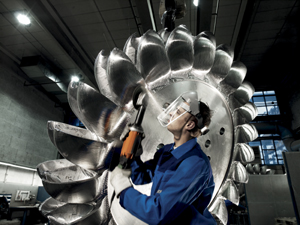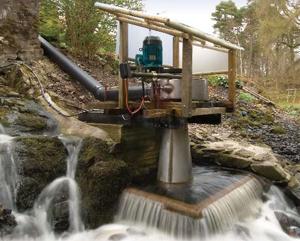Environmental rules threaten small hydropower production in Europe
on
Environmental regulation threatens small hydropower production in Europe
Small hydropower producers in Europe are sounding the alarm. Many are unable to expand or even to maintain power production as a result of growing opposition both from local authorities and environmental groups. In particular, it is the implementation of the EU’s Water Framework Directive into national laws that is making life increasingly difficult for the producers. In Italy, they have now banded together with WWF Italy to develop a “green” certification procedure, called CH2OICE, in the hope of stemming the negative tide.
 |
| Manufacturing hydro power turbines (Photo: Andreas Hofer /ANDRITZ HYDRO) |
Just last Tuesday, ESHA published the results of a detailed investigation into the European hydropower sector. It gathered statistical, market and policy oriented information which is now stored in a publicly available, extensive “hydro database”. The database shows that small hydropower plants (SHP’s), of up to 10 Megawatt, produce some 46 TWh (Terrawatthours) of electricity annually in the EU-27. That is about 1.5% of total power production and 9% of renewable energy production – enough to supply power to 13 million households. (Note that all hydropower production, i.e. including large hydropower plants of 10 MW and more, is good for 9% of total EU power production and over 60% of renewable energy production.) The six largest SHP-countries are Italy at the top, followed by France, Spain, Germany, Austria and Sweden. Non-EU members Switzerland and Norway also have a high SHP-capacity.
ESHA estimates the growth potential of SHP at 1.75% per year, which could result in 54.7 TWh of power produced in 2020. Especially in the new member states Bulgaria, Czech Republic, Poland and Romania, and in (other) Balkan countries, there are opportunities for new plants. Currently there are some 21,000 SHP’s in Europe, some three-quarters of which are over 40 and even over 60 years old. (An SHP can have a lifetime of 100 years.) Many of the latter are in need of upgrading or refurbishment.
Both existing and new SHP’s, however, are finding it increasingly difficult to obtain or renew their licenses. ESHA gives many examples of this. In Poland the Ministry of Environment is considering a moratorium on any new permits for SHP’s. In Slovenia new rules have been issued on residual flow which will lead to a loss of production of 30 to 60% for new SHP’s, making any new SHP plants unprofitable. In France, a new river classification has made it impossible to establish SHP’s in many locations.
Intransparent and cumbersome
The common thread behind the anti-SHP sentiment is the EU’s Water Framework Directive (WFD), which was adopted in 2000, but whose implementation in national laws is only now being felt. Member States had to submit River Basin Management Plans to the Commission by the end of 2009. This is
| ‘The environmental authorities don't take into account the importance of small hydropower for renewable energy production' |
What current policy fails to take into account, says Fried, is the many benefits that SHP offers, both for the environment and the economy. ‘SHP helps countries to realise their renewable energy targets. If SHP is held back, other production methods have to be used. These also have impacts on the environment.’ Moreover, argues Fried, SHP is a local form of power production, which has a positive effect on employment and security of supply, and it can serve as backup for variable forms of power production, such as solar and wind power. She also says that innovations such as infrared fish-fences are mitigating the environmental impact of SHP’s. Fried points out that in the US and in China small hydropower production is growing much faster than in Europe, because it is viewed in a much more positive light in those countries.
One problem in Europe, says Fried, is that there is generally no coordination between authorities that are responsible for implementing the WFD and those that see to the development of renewable energy. ‘Those two tasks are usually subsumed under different Ministries, which do not communicate with each other. The environmental authorities don’t take into consideration the importance of SHP for renewable energy production.’
No easy task
Giulio Conte, a biologist who works for the Italian consulting company Ambiente, explains that the Water Framework Directive ‘basically says that rivers have to be returned to an earlier condition corresponding to limited degradation, the “reference state”, as it is called.
Conte notes that not only government authorities, but also local environmental groups are increasingly
| In the US and in China small hydropower production is growing much faster than in Europe, because it is viewed in a much more positive light in those countries |
This, says Conte, proved to be no easy task. It resulted in a three-year project in which river ecology experts worked together with producers and environmental groups to produce a certification system that guarantees the sustainability of an SHP. The new certification system, called CH2OICE, will be officially presented on 25 February at a conference in Rome.
High standards
In order to be certified, Conte explains, a hydropower plant has to fulfill fixed environmental conditions by carrying out appropriate measures to mitigate its impacts on the environment, in particular on fish, the plant community, water quality and morphological and hydrological conditions of the river. The measures have to be integrated in a management program, which then has to be carried out by the producer. CH2OICE has been tested successfully in nine hydropower plants in Italy and Slovenia.
CH2OICE sets very high standards, says Conte. ‘In fact, we found that many hydropower plants as presently managed were not sustainable. This was not always related to size. Some small ones could not be certified. One larger, 15 MW plant, had to reduce its water withdrawal by 1.5%, which means a correspondingly lower energy output.’ Conte says that these results were ‘disappointing for some of our partners. But we decided certification could only work if it was absolutely trustworthy. It has to be accepted by the environmental groups, otherwise it won’t work.’
 |
| Hydropower in the UK (Photo: Renewable Power News) |
Nevertheless, ESHA as well as the Italian association for SHP’s, have signed the “policy paper” that is part of CH2OICE and that will be presented at the conference in Rome, even if with certain reservations.
Swiss consumers
In any case, CH2OICE will remain a voluntary instrument. ‘We expect that it can help producers in legal procedures, but also to sell their electricity at a premium, because it will be certified as green electricity’, says Conte. ‘A similar system already works in this way in Switzerland.’
True, says Fried, but, she adds, ‘Swiss consumers have a high environmental awareness and can afford higher prices. It won’t be so easy in other countries.’ Real relief for the small hydropower producers, she thinks, will have to come from changes in policy.
Conte agrees. ‘There is not enough awareness of the problem among policymakers. The Energy Directorate in Brussels is not really aware of the impact on hydropower production that the Water Framework Directive is having.’
|
All you need to know about Small Hydropower Plants … Until recently it was quite difficult to find up-to-date information on small hydropower production in Europe – even on the website of ESHA, the European Association of Small Hydropower Producers. On 15 February, however, ESHA launched a hydro database, which contains a wealth of statistical and policy-related information on small hydropower production in the EU, on a country by country basis. The database, which was co-financed by the Intelligent Energy Europe (IEE) Programme of the European Commission, will lead to a Roadmap for the Small Hydropower sector, analyzing upcoming trends and prospects for the future. For more information on the CH2OICE certification procedure and the final CH2OICE conference on 25 February in Rome, see here. |


Discussion (0 comments)